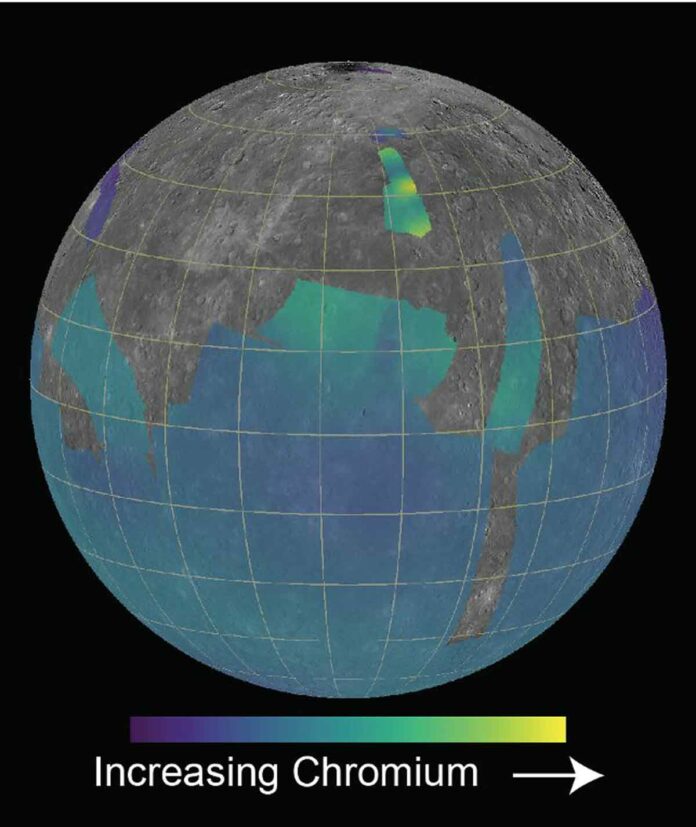Mercury, the enigmatic planet closest to the sun, has long puzzled scientists with its unusual characteristics.
Now, a groundbreaking study led by Arizona State University scientist Larry Nittler has shed light on the planet’s composition, unveiling fascinating insights into its origin and geological history.
The research, conducted using data acquired during NASA’s MESSENGER mission, focuses on the presence and distribution of a minor element called chromium across Mercury’s surface.
Chromium, known for its shine and resistance to corrosion, plays a crucial role in understanding the chemical conditions during the planet’s formation.
Nittler and his team discovered that chromium varies significantly across Mercury, with a fourfold difference in abundance.
To investigate further, they developed theoretical models that simulated the separation of the planet into a crust, mantle, and core under different conditions.
By comparing these models with the measured chromium distribution, the researchers made an intriguing discovery: Mercury’s large metallic core contains chromium, providing new constraints on the planet’s overall oxidation state.
"This is the first time that chromium has been directly detected and mapped across any planetary surface," Nittler remarked.
The findings, published in the Journal of Geophysical Research: Planets, present a milestone in our understanding of Mercury’s unique chemistry.
Unveiling the Secrets of Mercury’s Chromium Distribution
Chromium’s diverse chemical states make it an invaluable indicator of the processes that shaped Mercury.
Nittler’s team, in collaboration with Asmaa Boujibar of Western Washington University, used laboratory experiments and state-of-the-art modeling techniques to unravel the distribution of chromium within the planet’s layers.
The results corroborated the hypothesis that a significant portion of chromium is concentrated within Mercury’s core, analogous to iron.
As the planet becomes increasingly oxygen-deficient, more chromium becomes hidden within its interior.
This revelation paves the way for a deeper understanding of the elemental composition and geological dynamics at play on Mercury.
"Our model, based on laboratory experiments, confirms that the majority of chromium in Mercury is concentrated within its core," Boujibar explained.
She emphasized the importance of simulating the specific oxygen-deficient environment in which the planet was formed, highlighting the need for experiments distinct from those conducted on Earth or Mars.
Implications for Mercury’s Formation and Geological History
By elucidating the chromium distribution on Mercury’s surface, Nittler’s study offers unprecedented insights into the planet’s origin and geological evolution.
The presence of relatively less oxygen on Mercury indicates that it formed from different building blocks than Earth, a fact further supported by the measured chromium abundance.
The research team’s innovative approach provides a stepping stone for future investigations into Mercury’s composition.
By conducting experiments that simulate the planet’s unique conditions, scientists can continue to unravel the mysteries surrounding Mercury and refine our understanding of the formation and development of rocky planets in our solar system.
With each new discovery, the scientific community moves closer to comprehending the intricate tapestry of our cosmic neighborhood.
The study of Mercury’s chromium distribution stands as a testament to humanity’s insatiable curiosity and unwavering dedication to unraveling the secrets of the universe.
In the vast expanse of space, Mercury’s allure continues to captivate us. As researchers push the boundaries of knowledge, the enigma surrounding this fascinating planet slowly unravels, bringing us one step closer to understanding the wonders that lie beyond our own blue planet.
FAQs
Chromium plays a crucial role in understanding the chemical conditions during a planet’s formation. By studying the distribution of chromium on Mercury’s surface, scientists can gain insights into the planet’s origin and geological history.
The measurements of chromium on Mercury were obtained using data collected during NASA’s MESSENGER mission. These measurements were then used to create theoretical models that simulated the separation of the planet into different layers under varying conditions.
The study revealed that chromium varies significantly across Mercury’s surface, with a fourfold difference in abundance. The researchers found that a substantial amount of chromium is concentrated within the planet’s large metallic core.
By analyzing the chromium distribution, the researchers were able to put new limits on Mercury’s overall oxidation state. The presence of chromium in the planet’s core suggests that Mercury has a unique composition and differs chemically from Earth.
The study provides valuable insights into the elemental composition of Mercury. It confirms that a significant portion of chromium, similar to iron, is sequestered within the planet’s core. This knowledge contributes to our understanding of the geological processes and formation conditions at play on Mercury.
No, due to the unique composition and formation conditions of Mercury, direct comparisons between its surface composition and that of rocks on Earth or Mars are not possible. Conducting experiments that simulate Mercury’s specific oxygen-deficient environment is essential to gain a better understanding of the planet’s chemistry.
The study opens doors for further investigations into Mercury’s composition and geological dynamics. Scientists can now refine their models and conduct experiments that simulate the conditions under which Mercury was formed. This will contribute to a deeper understanding of rocky planet formation within our solar system.
Studying Mercury’s composition and distribution of elements like chromium provides valuable insights into the formation and evolution of rocky planets in general. By unraveling the mysteries of our neighboring planets, scientists can enhance their understanding of the broader processes that shape our solar system and beyond.
More information: Journal of Geophysical Research: Planets (2023). DOI: 10.1029/2022JE007691

